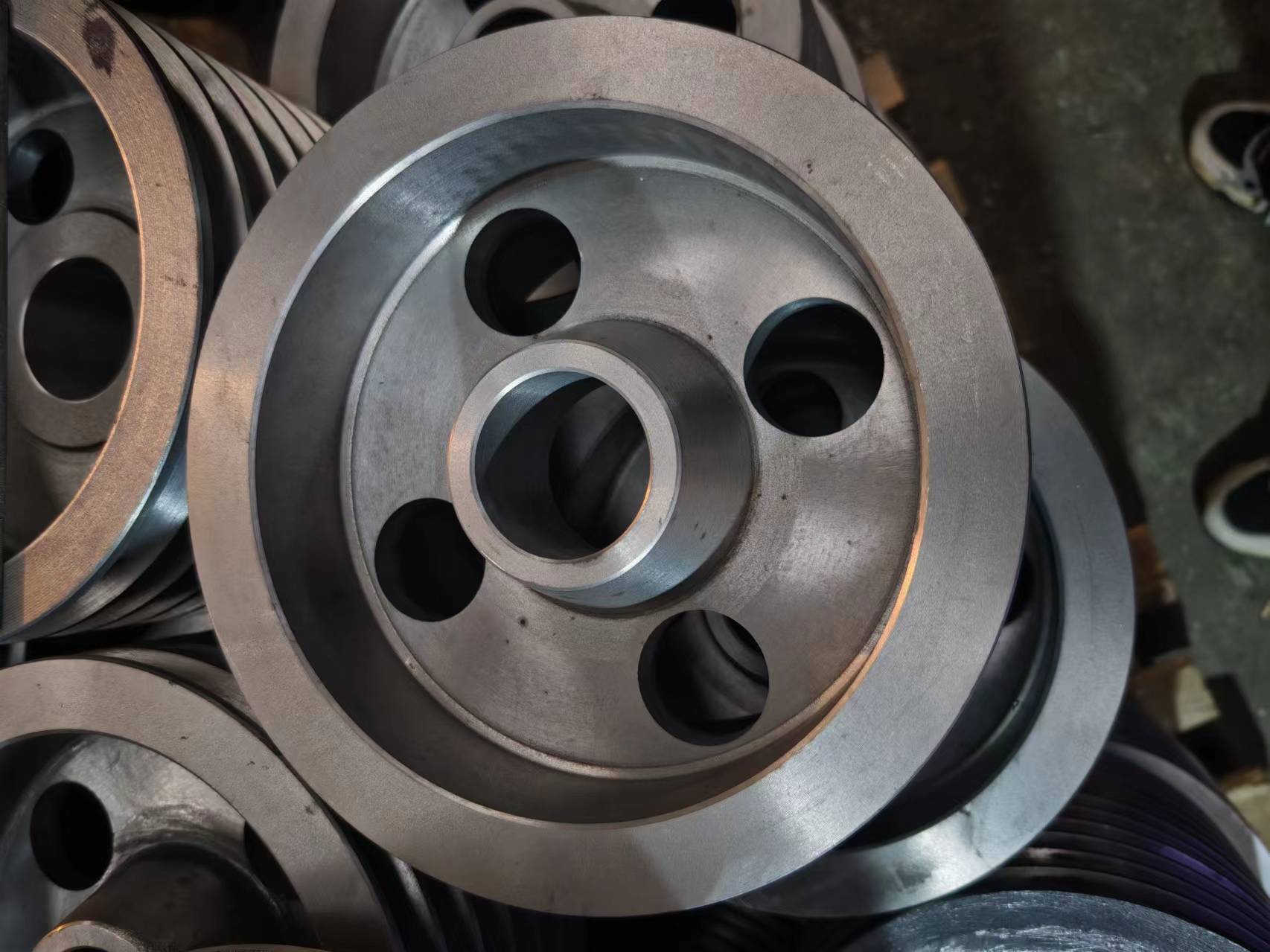The role of commonly used elements in gray cast iron
1.Carbon and silicon: Carbon and silicon are elements that strongly promote graphitization. Carbon equivalent can be used to illustrate their effects on the metallographic structure and mechanical properties of gray cast iron. Increasing the carbon equivalent causes the graphite flakes to become coarser, increase in number, and decrease in strength and hardness. On the contrary, reducing the carbon equivalent can reduce the number of graphites, refine graphite, and increase the number of primary austenite dendrites, thereby improving the mechanical properties of gray cast iron. However, reducing the carbon equivalent will lead to a decrease in casting performance.
2.Manganese: Manganese itself is an element that stabilizes carbides and hinders graphitization. It has the effect of stabilizing and refining pearlite in gray cast iron. In the range of Mn=0.5% to 1.0%, increasing the amount of manganese is conducive to improving strength and hardness.
3.Phosphorus: When the phosphorus content in cast iron exceeds 0.02%, intergranular phosphorus eutectic may occur. The solubility of phosphorus in austenite is very small. When cast iron solidifies, phosphorus basically remains in the liquid. When the eutectic solidification is nearly complete, the remaining liquid phase composition between the eutectic groups is close to the ternary eutectic composition (Fe-2%, C-7%, P). This liquid phase solidifies at about 955℃. When cast iron solidifies, molybdenum, chromium, tungsten and vanadium are all segregated in the phosphorus-rich liquid phase, increasing the amount of phosphorus eutectic. When the phosphorus content in cast iron is high, in addition to the harmful effects of the phosphorus eutectic itself, it will also reduce the alloying elements contained in the metal matrix, thereby weakening the effect of the alloying elements. The phosphorus eutectic liquid is mushy around the eutectic group that solidifies and grows, and it is difficult to get replenished during solidification shrinkage, and the casting has a greater tendency to shrink.
4.Sulfur: It reduces the fluidity of molten iron and increases the tendency of castings to crack hot. It is a harmful element in castings. Therefore, many people think that the lower the sulfur content, the better. In fact, when the sulfur content is ≤0.05%, this kind of cast iron does not work for the ordinary inoculant we use. The reason is that the inoculation decays very quickly, and white spots often appear in the castings.
5.Copper: Copper is the most commonly added alloying element in the production of gray cast iron. The main reason is that copper has a low melting point (1083℃), is easy to melt, and has a good alloying effect. The graphitization ability of copper is about 1/5 of that of silicon, so it can reduce the tendency of cast iron to have a white cast. At the same time, copper can also reduce the critical temperature of austenite transformation. Therefore, copper can promote the formation of pearlite, increase the content of pearlite, and refine pearlite and strengthen pearlite and ferrite therein, thereby increasing the hardness and strength of cast iron. However, the higher the amount of copper, the better. The appropriate amount of copper added is 0.2% to 0.4%. When adding a large amount of copper, adding tin and chromium at the same time is harmful to the cutting performance. It will cause a large amount of sorbite structure to be produced in the matrix structure.
6.Chromium: The alloying effect of chromium is very strong, mainly because the addition of chromium increases the tendency of molten iron to have a white cast, and the casting is easy to shrink, resulting in waste. Therefore, the amount of chromium should be controlled. On the one hand, it is hoped that the molten iron contains a certain amount of chromium to improve the strength and hardness of the casting; on the other hand, the chromium is strictly controlled at the lower limit to prevent the casting from shrinking and causing an increase in the scrap rate. Traditional experience holds that when the chromium content of the original molten iron exceeds 0.35%, it will have a fatal effect on the casting.
7. Molybdenum: Molybdenum is a typical compound-forming element and a strong pearlite stabilizing element. It can refine graphite. When ωMo<0.8%, molybdenum can refine pearlite and strengthen the ferrite in pearlite, thereby effectively improving the strength and hardness of cast iron.
Several issues in gray cast iron must be noted
1.Increasing the overheating or extending the holding time can make the existing heterogeneous cores in the melt disappear or reduce their effectiveness, reducing the number of austenite grains.
2.Titanium has the effect of refining primary austenite in gray cast iron. Because titanium carbides, nitrides, and carbonitrides can serve as the basis for austenite nucleation. Titanium can increase the core of austenite and refine austenite grains. On the other hand, when there is excess Ti in the molten iron, the S in the iron will react with Ti instead of Mn to form TiS particles. The graphite core of TiS is not as effective as that of MnS. Therefore, the formation of eutectic graphite core is delayed, thereby increasing the precipitation time of primary austenite. Vanadium, chromium, aluminum, and zirconium are similar to titanium in that they are easy to form carbides, nitrides, and carbonitrides, and can become austenite cores.
3.There are great differences in the effects of various inoculants on the number of eutectic clusters, which are arranged in the following order: CaSi>ZrFeSi>75FeSi>BaSi>SrFeSi. FeSi containing Sr or Ti has a weaker effect on the number of eutectic clusters. Inoculants containing rare earths have the best effect, and the effect is more significant when added in combination with Al and N. Ferrosilicon containing Al and Bi can strongly increase the number of eutectic clusters.
4. The grains of graphite-austenite two-phase symbiotic growth formed with graphite nuclei as the center are called eutectic clusters. Submicroscopic graphite aggregates, residual unmelted graphite particles, primary graphite flake branches, high melting point compounds and gas inclusions that exist in molten iron and can be the cores of eutectic graphite are also the cores of eutectic clusters. Since the eutectic nucleus is the starting point of the growth of the eutectic cluster, the number of eutectic clusters reflects the number of cores that can grow into graphite in the eutectic iron liquid. Factors affecting the number of eutectic clusters include chemical composition, the core state of the molten iron and the cooling rate.
The amount of carbon and silicon in the chemical composition has an important influence. The closer the carbon equivalent is to the eutectic composition, the more eutectic clusters there are. S is another important element that affects the eutectic clusters of gray cast iron. Low sulfur content is not conducive to increasing the eutectic clusters, because the sulfide in the molten iron is an important substance of the graphite core. In addition, sulfur can reduce the interfacial energy between the heterogeneous core and the melt, so that more cores can be activated. When W (S) is less than 0.03%, the number of eutectic clusters is significantly reduced, and the effect of inoculation is reduced.
When the mass fraction of Mn is within 2%, the amount of Mn increases, and the number of eutectic clusters increases accordingly. Nb is easy to generate carbon and nitrogen compounds in the molten iron, which acts as a graphite core to increase the eutectic clusters. Ti and V reduce the number of eutectic clusters because vanadium reduces the carbon concentration; titanium easily captures S in MnS and MgS to form titanium sulfide, and its nucleation ability is not as effective as MnS and MgS. N in the molten iron increases the number of eutectic clusters. When the N content is less than 350 x10-6, it is not obvious. After exceeding a certain value, the supercooling increases, thereby increasing the number of eutectic clusters. Oxygen in molten iron easily forms various oxide inclusions as cores, so as the oxygen increases, the number of eutectic clusters increases. In addition to the chemical composition, the core state of the eutectic melt is an important influencing factor. Maintaining high temperature and overheating for a long time will cause the original core to disappear or decrease, reduce the number of eutectic clusters, and increase the diameter. Inoculation treatment can greatly improve the core state and increase the number of eutectic clusters. The cooling rate has a very obvious effect on the number of eutectic clusters. The faster the cooling, the more eutectic clusters there are.
5.The number of eutectic clusters directly reflects the thickness of the eutectic grains. In general, fine grains can improve the performance of metals. Under the premise of the same chemical composition and graphite type, as the number of eutectic clusters increases, the tensile strength increases, because the graphite sheets in the eutectic clusters become finer as the number of eutectic clusters increases, which increases the strength. However, with the increase of silicon content, the number of eutectic groups increases significantly, but the strength decreases instead; the strength of cast iron increases with the increase of superheat temperature (to 1500℃), but at this time, the number of eutectic groups decreases significantly. The relationship between the change law of the number of eutectic groups caused by long-term inoculation treatment and the increase in strength does not always have the same trend. The strength obtained by inoculation treatment with FeSi containing Si and Ba is higher than that obtained with CaSi, but the number of eutectic groups of cast iron is much less than that of CaSi. With the increase of the number of eutectic groups, the shrinkage tendency of cast iron increases. In order to prevent the formation of shrinkage in small parts, the number of eutectic groups should be controlled below 300~400/cm2.
6. Adding alloy elements (Cr, Mn, Mo, Mg, Ti, Ce, Sb) that promote supercooling in graphitized inoculants can improve the degree of supercooling of cast iron, refine the grains, increase the amount of austenite and promote the formation of pearlite. The added surface active elements (Te, Bi, 5b) can be adsorbed on the surface of graphite nuclei to limit graphite growth and reduce graphite size, so as to achieve the purpose of improving comprehensive mechanical properties, improving uniformity, and increasing organizational regulation. This principle has been applied in the production practice of high carbon cast iron (such as brake parts).
Post time: Jun-05-2024






